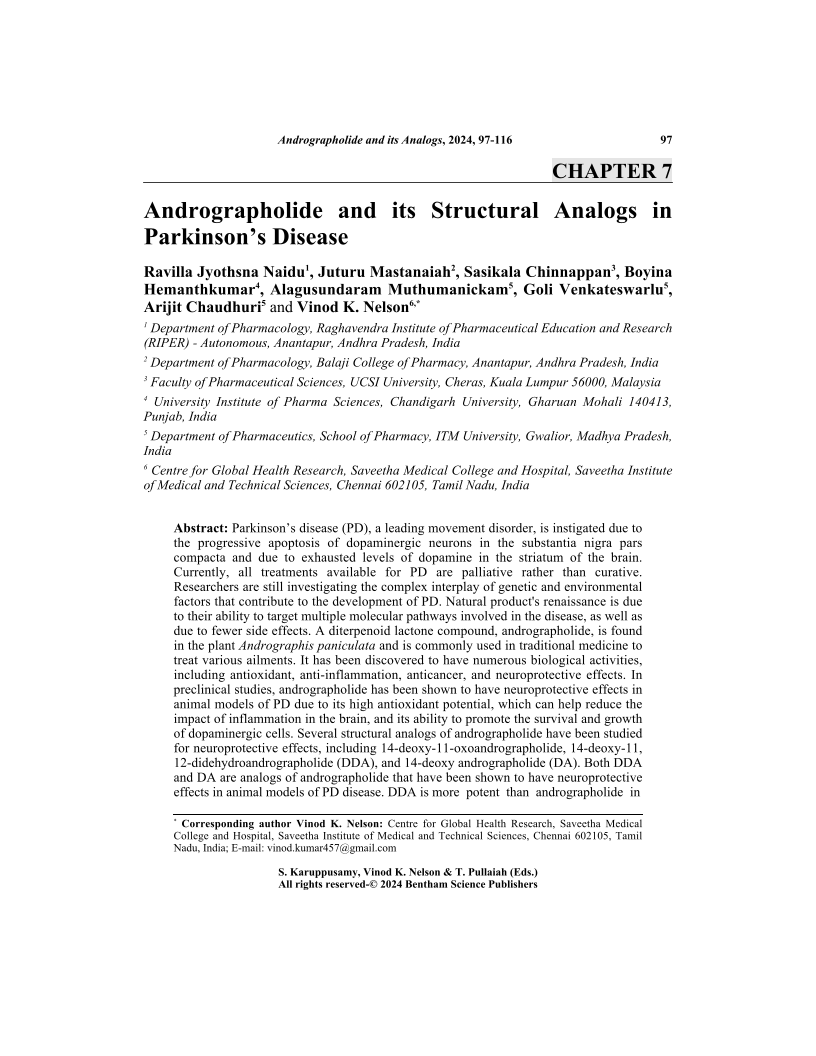Andrographolide and its Structural Analogs in Parkinson's Disease

- Authors: Ravilla Jyothsna Naidu1, Juturu Mastanaiah2, Sasikala Chinnappan3, Hemanth Kumar4, Alagusundaram Muthumanickam5, Goli Venkateswarlu6, Arijit Chaudhuri7, Vinod K. Nelson8
-
View Affiliations Hide Affiliations1 Department of Pharmacology, Raghavendra Institute of Pharmaceutical Education and Research (RIPER) Autonomous, Anantapur, Andhra Pradesh, India 2 Department of Pharmacology, Balaji College of Pharmacy, Anantapur, Andhra Pradesh, India 3 Faculty of Pharmaceutical Sciences, UCSI University, Cheras, Kuala Lumpur 56000, Malaysia 4 Department of Pharmacology, School of Pharmacy, Anurag University, Ghatkesar, Medchal, Hyderabad, Telangana 500088, India 5 Department of Pharmaceutics, School of Pharmacy, ITM University, Gwalior, Madhya Pradesh, India 6 Department of Pharmaceutics, School of Pharmacy, ITM University, Gwalior, Madhya Pradesh, India 7 Department of Pharmaceutics, School of Pharmacy, ITM University, Gwalior, Madhya Pradesh, India 8 Centre for Global Health Research, Saveetha Medical College and Hospital, Saveetha Institute of Medical and Technical Sciences, Chennai 602105, Tamil Nadu, India
- Source: Andrographolide and its Analogs: Botanical Sources, Phytochemistry, Pharmacology, and Biotechnology , pp 97-116
- Publication Date: December 2024
- Language: English
Andrographolide and its Structural Analogs in Parkinson's Disease, Page 1 of 1
< Previous page | Next page > /docserver/preview/fulltext/9789815256567/chapter-7-1.gif
Parkinson's disease (PD), a leading movement disorder, is instigated due to the progressive apoptosis of dopaminergic neurons in the substantia nigra pars compacta and due to exhausted levels of dopamine in the striatum of the brain. Currently, all treatments available for PD are palliative rather than curative. Researchers are still investigating the complex interplay of genetic and environmental factors that contribute to the development of PD. Natural product's renaissance is due to their ability to target multiple molecular pathways involved in the disease, as well as due to fewer side effects. A diterpenoid lactone compound, andrographolide, is found in the plant Andrographis paniculata and is commonly used in traditional medicine to treat various ailments. It has been discovered to have numerous biological activities, including antioxidant, anti-inflammation, anticancer, and neuroprotective effects. In preclinical studies, andrographolide has been shown to have neuroprotective effects in animal models of PD due to its high antioxidant potential, which can help reduce the impact of inflammation in the brain, and its ability to promote the survival and growth of dopaminergic cells. Several structural analogs of andrographolide have been studied for neuroprotective effects, including 14-deoxy-11-oxoandrographolide, 14-deoxy-11, 12-didehydroandrographolide (DDA), and 14-deoxy andrographolide (DA). Both DDA and DA are analogs of andrographolide that have been shown to have neuroprotective effects in animal models of PD disease. DDA is more potent than andrographolide in terms of neuroprotection. The anti-inflammatory and antioxidant properties of 14- deoxy-11, 14-deoxy-11, 12-didehydroandrographolide-19-oic acid (DDAA), and 7-- -Methyl-andrographolide were found to be more potent than andrographolide. On the other hand, andrographolide derivatives, such as 14-deoxyandrographolide, andrographolide epoxide, and andrographolide sulfonates possess potent antiinflammatory and anticancer properties. Given that andrographolide and its structural analogs and derivatives have substantial therapeutic potential and have been proven to be neuroprotective, we intend to highlight this promising compound's role in PD disease.
-
From This Site
/content/books/9789815256567.chapter-7dcterms_subject,pub_keyword-contentType:Journal -contentType:Figure -contentType:Table -contentType:SupplementaryData105

